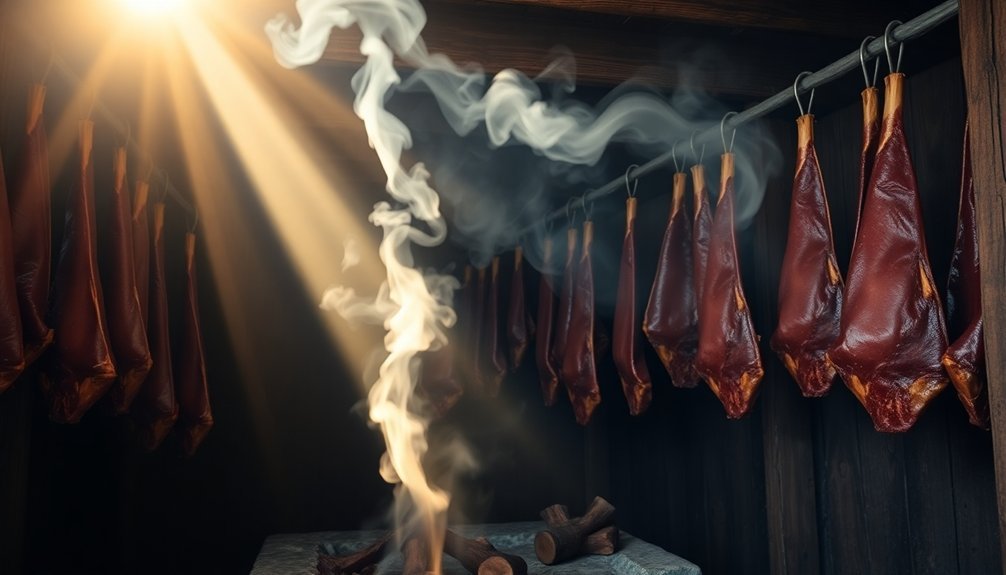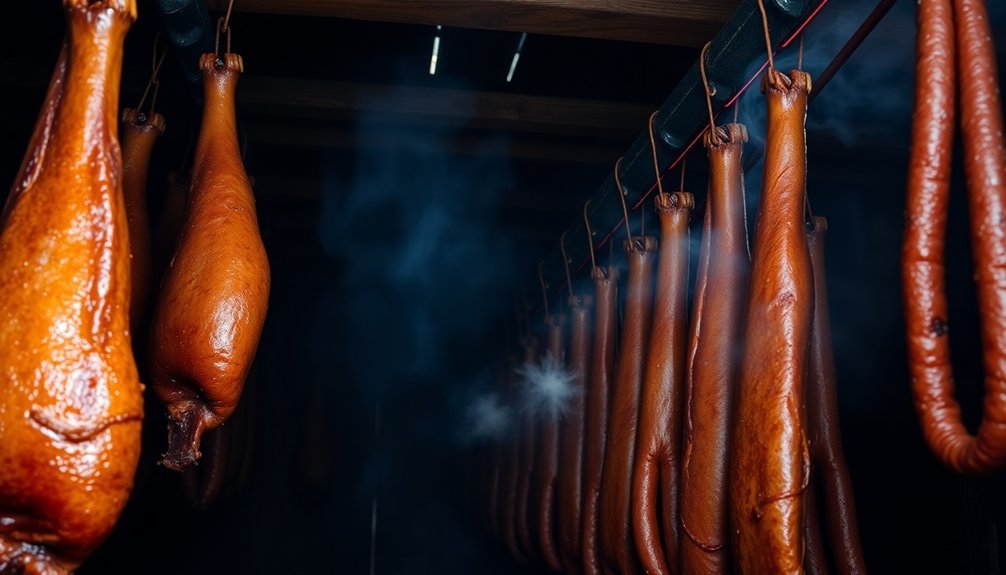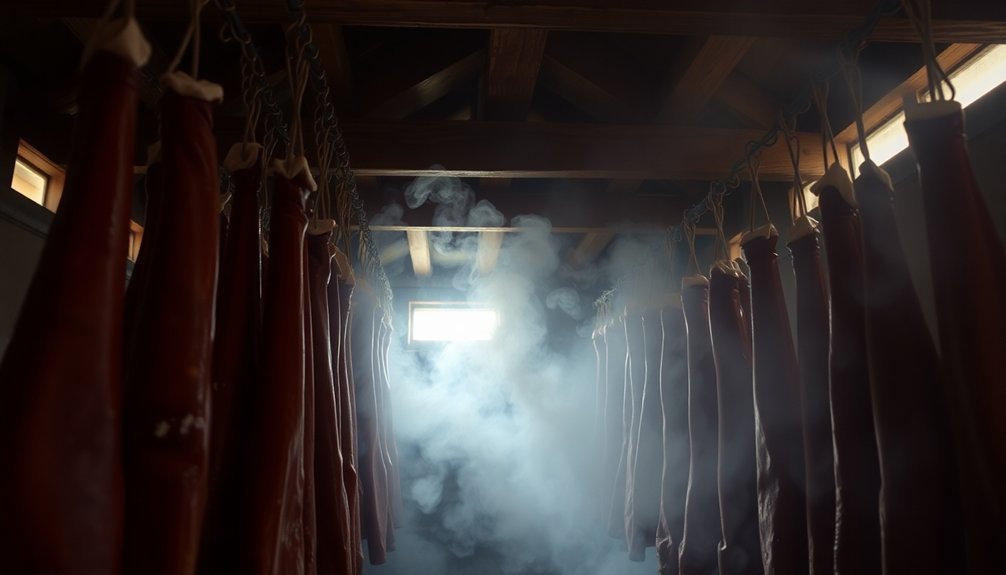Smoke-cured meat's incredible longevity comes from three key preservation methods working together. When you smoke meat, you're combining the dehydrating effects of salt, which draws out moisture bacteria need to survive, with the natural antimicrobial compounds found in wood smoke. The smoking process also creates a protective outer layer that shields the meat from environmental factors. Traditional methods passed down through generations rely on specific temperature controls, usually between 160-180°F, and careful moisture management to achieve preservation that can last for centuries. Discover how ancient civilizations perfected these techniques to create lasting sustenance.
Ancient Origins of Meat Preservation

Throughout human history, the need to preserve meat has driven innovation in food storage techniques. You'll find evidence of prehistoric humans first discovering that smoke from their fires could effectively dry and flavor meat, leading to one of civilization's earliest preservation methods. Portable smoking devices make it possible to preserve meat almost anywhere you go.
When you look at ancient Egypt, Greece, and Rome, you'll see they refined these smoking techniques by creating dedicated smokehouses and developing systematic approaches to meat preservation. They weren't alone – in the Middle East and Oriental cultures, people were already using dehydration and smoking methods as far back as 12,000 B.C.
You'd be amazed at how these early preservation techniques spread and evolved. During the Middle Ages, European monasteries became centers of innovation for smoking methods, while indigenous peoples across continents developed their own unique approaches.
The Incas mastered freeze-drying at high altitudes, and African cultures created biltong through a combination of vinegar treatment and sun-drying. When European explorers encountered Native American tribes, they quickly adopted and adapted their smoking techniques, leading to a rich exchange of preservation knowledge that would influence modern practices.
The Science Behind Smoke Curing
Three fundamental processes work together in smoke curing: heat control, chemical preservation, and moisture reduction. When you smoke meat, the heat kills surface microbes while maintaining temperatures around 160 degrees for at least 30 minutes guarantees you've eliminated harmful parasites and pathogens.
The chemicals in wood smoke, particularly from hardwoods like hickory, apple, and oak, settle on the meat's surface and act as natural preservatives. These compounds prevent microbial growth while simultaneously contributing to the drying process. You'll get the best results using specific hardwoods, as they contain superior preservative properties. This method has been perfected over time, evolving from prehistoric preservation techniques.
What's essential to understand is that smoking alone won't preserve your meat long-term. You'll need to combine it with other preservation methods, particularly curing and drying.
When you add salt to the process, it accelerates moisture reduction and enhances the preservative effects. The addition of nitrites and nitrates in the curing process helps prevent dangerous bacteria like Clostridium botulinum from forming.
For the best preservation outcomes, you'll want to maintain strict sanitary conditions and proper handling throughout the entire process.
Salt and Nitrites Role

When you're preserving meat through smoke curing, salt works through two essential mechanisms: drawing out moisture and creating an inhospitable environment for harmful microorganisms.
Traditional curing methods have been used for generations to create beloved products like bacon and ham. You'll find that nitrites complement salt's preservative action by converting to nitric oxide, which prevents dangerous bacteria like Clostridium botulinum from growing.
These chemical reactions not only guarantee your meat stays safe but also contribute to the characteristic pink color and enhanced flavor profile of properly cured meats.
Salt's Dual Preservation Action
Salt's preservation power in meat curing operates through two distinct mechanisms that work together to create safe, long-lasting products. When you apply salt to meat, it begins drawing out moisture through osmosis, creating an environment where harmful bacteria can't thrive. This moisture reduction transforms your meat's texture, making it firmer and more resistant to spoilage.
The second preservation mechanism involves salt's direct impact on microorganisms. You'll find that salt actively inhibits harmful bacteria while promoting beneficial ones that produce lactic acid, enhancing both safety and flavor. This dual action has made salt an invaluable preservation tool for centuries.
- Salt draws moisture out consistently over 5-14 days, depending on meat thickness
- The meat becomes noticeably firmer and more rigid as moisture levels decrease
- Beneficial bacteria produce lactic acid, creating additional protection
- Salt's preservation method doesn't require precise measurements like modern curing salts
- The process works effectively without additional preservatives or anti-caking agents
When combined with nitrites, salt's preservation power increases considerably, creating an even more robust defense against harmful bacteria while improving flavor and extending shelf life.
Chemical Reactions Of Nitrites
Nitrites play an important role in meat curing by triggering several essential chemical reactions. When you add nitrites to meat, they undergo a series of transformations that preserve and enhance the final product.
First, nitrites convert to nitric oxide, which then combines with myoglobin in the meat to form nitrosohemochrome – the compound responsible for that distinctive pink color you see in cured meats.
The chemical process begins when nitrites react with water to form nitrous acid, a vital intermediate step in the curing reaction. You'll find that nitrites work as powerful antioxidants, preventing fat from becoming rancid while simultaneously binding water molecules.
This binding action helps control dangerous microbes that could spoil your meat.
What's particularly interesting is how nitrites interact with different compounds in the meat. They'll form acids or salts depending on the conditions, and they'll also produce important flavor compounds that give cured meats their characteristic taste.
The entire process is carefully controlled, especially since World War II when direct nitrite addition became standard practice, ensuring both safety and consistency in the final product.
Traditional Woods for Smoking
Your choice of smoking wood profoundly influences the final taste of your cured meats, with traditional hardwoods like hickory and oak delivering the rich, complex flavors that have endured for centuries.
You'll find that ancient smoke-curing techniques favored specific woods for their unique properties: hickory for its sweet-strong profile with pork and beef, oak for its heavy smoke ideal for brisket, and fruit woods like apple and cherry for their milder, sweeter notes with poultry.
Through generations of trial and error, our ancestors discovered that hardwoods burn longer, produce cleaner smoke, and create more consistent results than softwoods, which is why they remain the cornerstone of modern smoke-curing.
Classic Hardwood Smoke Properties
Classic hardwood smoke stands as a time-tested cornerstone of meat preservation, delivering both protective and flavor-enhancing properties. When you're smoking meat, the hardwood smoke deposits a thin, acidic film on the surface that creates an inhospitable environment for harmful bacteria.
You'll find natural preservatives like formaldehyde and specific alcohols working together to inhibit bacterial growth while simultaneously dehydrating the meat.
The antimicrobial properties of hardwood smoke are particularly impressive, featuring compounds like phenols and organic acids that effectively combat food-borne pathogens such as Listeria and Salmonella.
You'll notice that different hardwoods impart unique flavor profiles to your meat, with each variety offering its own distinctive taste and aroma.
Here's what makes hardwood smoke so effective:
- Creates a protective acidic barrier on meat surfaces
- Contains natural antimicrobial compounds that fight harmful bacteria
- Reduces moisture content through controlled dehydration
- Imparts rich, complex flavors that vary by wood type
- Combines preservation and flavor enhancement in one process
When choosing your smoking wood, you'll want to stick with hardwoods like hickory, cherry, apple, or maple, avoiding softwoods that can leave bitter, unpleasant tastes in your meat.
Ancient Wood Selection Wisdom
Ancient civilizations discovered three fundamental principles of wood selection that still guide modern smoking practices today.
First, they recognized that fruit woods like apple, cherry, and plum offered mild, sweet smoke that preserved meat without overpowering its natural flavors. You'll find these woods remain popular because they're versatile and produce consistent results when properly dried.
Second, they learned that certain hardwoods created perfect smoking conditions. Oak became a go-to choice for its slow, even burn and mild flavor profile, while hickory earned respect for its robust smokiness. You won't want to use resinous woods, as ancient smokers discovered they produced sooty, strong-smelling smoke that ruined meat.
Third, they understood the critical importance of wood moisture content. You'll need properly seasoned wood that's been dried for at least six months or kiln-dried for best results.
While some moisture helps control temperature, green wood produces irregular burns and pungent smoke. That's why traditional smoke houses were carefully designed with proper wood storage areas, keeping the wood elevated and protected from ground moisture to guarantee consistent smoking results.
Temperature Control Through History

Throughout history, meat preservation through smoke-curing has relied heavily on temperature control methods that evolved from basic pit smoking to today's precise digital systems. Early preservers would dig pits and maintain fires under logs, creating continuous smoke exposure over several days. They'd primarily work during spring and fall when temperatures naturally stayed between 50-70°F, ideal for cold smoking.
The introduction of curing agents revolutionized temperature control in smoking. Using Cure #1 made it safe to smoke meat at temperatures between 40-100°F, though refrigeration was still needed for items smoked below 140°F.
Modern smoking requires careful monitoring of the danger zone (40-140°F) and specific internal cooking temperatures.
- Ancient smokers relied on ambient temperatures and seasonal timing
- Cure #1 allowed for safe cold smoking at lower temperatures
- Internal meat temperatures must reach 160°F to kill harmful bacteria
- Modern smokehouses use calibrated thermometers for precise control
- Semi-dry sausages require heating to 145°F for 4 minutes to destroy E. coli
Today's smoke-curing follows strict safety standards, with carefully controlled temperature progression from 130°F up to 170°F during the cool smoking process. Quick cooling and proper storage complete the preservation cycle.
Moisture Management in Preservation
Every successful smoke-curing process hinges on proper moisture management to prevent spoilage and extend shelf life. You'll find that moisture control plays a dual role: first, by reducing water content to inhibit microbial growth, and second, by creating an environment where harmful bacteria can't thrive.
When you're smoke-curing meat, you're actually combining multiple preservation techniques. The smoking process deposits an acidic film on the meat's surface, while simultaneously drawing out moisture.
You'll often pair this with salting and drying, which further reduces the meat's water activity. This combination approach is particularly effective because it targets different aspects of preservation simultaneously.
To achieve the best results, you'll need to maintain consistent moisture removal throughout the curing process. You can enhance this through controlled air circulation and dehumidification.
The smoke itself acts as a natural dehydrator, while the chemical compounds it contains help preserve the meat's quality. By maintaining proper moisture levels, you're not just preventing spoilage – you're also preserving nutrients and flavors that make smoke-cured meat so distinctive.
This careful moisture management is what allows properly cured meats to last for extended periods, sometimes even centuries.
Environmental Factors and Storage

Successful storage of smoke-cured meats depends on four critical environmental factors: temperature, humidity, air circulation, and light exposure.
You'll need to maintain consistent cool temperatures while keeping humidity levels low to prevent bacterial growth. Good air circulation helps maintain dry conditions, and protecting your meat from direct sunlight prevents rapid degradation.
To maximize your smoke-cured meat's longevity, you'll want to use proper storage methods like airtight containers or vacuum packaging. While refrigeration isn't mandatory, it can greatly extend shelf life.
You should also regularly monitor for signs of spoilage and maintain clean storage conditions to prevent cross-contamination.
Here are essential storage practices you'll need to follow:
- Store in a cool, dry place like a pantry or cellar, away from temperature fluctuations
- Use airtight containers or vacuum-sealed bags to protect from external odors and moisture
- Label all packages with dates and rotate stock to guarantee older pieces are used first
- Keep storage areas clean and well-ventilated to prevent moisture accumulation
- Regularly inspect for signs of spoilage such as sliminess, odd colors, or unusual smells
Preservation Techniques Across Cultures
Diverse cultures worldwide have developed unique approaches to smoke-curing meat, each reflecting local traditions and available resources.
You'll find that these techniques often combine salt curing with smoking, creating preservation methods that have stood the test of time.
In traditional country ham production, you'll notice specific combinations of wood types and smoking durations that have been passed down through generations.
Whether you're using apple wood for a sweet flavor or mesquite for a stronger taste, each wood type contributes unique characteristics to the preserved meat.
What you'll discover across different cultures is that the basic principles remain consistent: salt draws out moisture, while smoke creates an acidic barrier against bacteria.
However, you'll see variations in the spices and ingredients added during the curing process. Some cultures emphasize longer cold smoking periods, while others prefer hot smoking techniques.
When you're examining these preservation methods, you'll notice they're often adapted to local conditions.
Fish smoking techniques, for instance, vary greatly between coastal and inland regions, with each area developing methods that work best for their specific climate and available materials.
Modern Applications of Ancient Methods

Today's food preservation industry has brilliantly adapted traditional smoke-curing techniques for modern production needs. You'll find state-of-the-art smokehouses equipped with precise temperature controls and ventilation systems that guarantee consistent results every time.
When you're smoke-curing meat, you'll need to maintain temperatures below 40°F during the initial curing process, followed by either hot or cold smoking depending on your preservation goals.
Modern equipment has made it easier to achieve the perfect cure while maintaining safety standards. You'll want to use pure salt without additives and select the right hardwoods for smoking, avoiding toxic woods like pine or cedar.
Here are the key elements that make modern smoke-curing effective:
- Electric, gas, or pellet smokers provide consistent temperature control
- Controlled humidity settings prevent over-drying or moisture buildup
- Proper ventilation systems regulate smoke intensity and distribution
- Pure salt and carefully measured nitrates guarantee safe preservation
- Food-grade packaging materials extend shelf life considerably
For the best results, you'll need to store your cured meats in cool, dry places. While traditional methods could preserve meat for years, modern refrigeration can help maintain quality for about 30 days while following food safety guidelines.
Frequently Asked Questions
Can Smoke-Cured Meat Become Too Salty Over Extended Storage Periods?
Yes, your smoke-cured meat can become too salty during long storage periods. If you've noticed it's too salty, you can soak it in cold water for 10-15 minutes to help balance the flavor.
How Does Altitude Affect the Smoke-Curing Process and Preservation Time?
While altitude doesn't directly affect smoke-curing, you'll notice it can impact drying times and environmental conditions. You should adjust your curing duration based on local humidity and temperature rather than elevation alone.
Does Repeated Freezing and Thawing Impact the Preservative Effects of Smoke-Curing?
Yes, repeated freezing and thawing will compromise your smoke-cured meat's preservative effects. You'll notice degraded texture, increased moisture, and potential bacterial growth, though the smoke's chemical compounds remain present in the meat.
Can Different Animal Fats Affect the Longevity of Smoke-Cured Meats?
Yes, you'll find that meats with higher fat content last longer when smoke-cured. Different fats influence preservation rates – pork and beef fats typically provide better longevity than leaner meats like poultry.
What Role Do Natural Spices Play in Extending Preservation Time?
You'll find that natural spices enhance preservation through their antimicrobial properties. They'll inhibit bacterial growth, reduce moisture content, and prevent rancidity. When combined with smoking, they'll greatly extend your meat's shelf life.
In Summary
You've discovered that smoke-cured meat's remarkable longevity comes from multiple factors working together. When you combine proper salt levels, controlled temperatures, specific wood smoke compounds, and precise moisture management, you're replicating a preservation method that's served humanity for millennia. Whether you're using traditional methods or modern equipment, these time-tested principles still work to keep meat safe and edible for extended periods.





Leave a Reply